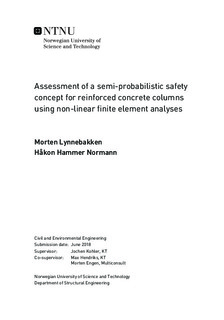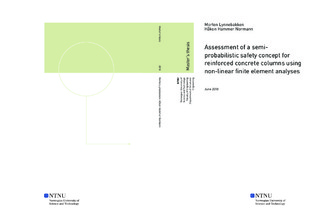| dc.description.abstract | This thesis assesses the reliability of methods for slender concrete column design, including Non-Linear Finite Element Analysis (NLFEA). The applicability of the Eurocode in slender column design is investigated, and the current safety format is assessed.
The Partial Safety Factor (PSF) method is a semi-probabilistic method where partial safety factors have been calibrated based on a linear Limit State Function (LSF). In slender structures, significant second-order effects cause geometric non-linearity. The combination of geometric non-linearity and the non-linear behavior of concrete, assessed in an NLFEA software, violate the assumption of a linear limit state. Nevertheless, the Eurocode suggests applying the PSF method to problems solved with NLFEA.
The PSF method is compared with two alternative safety formats, namely the Global Resistance Factor Method (GRFM) and the method of Estimate of Coefficient Of Variation (ECOV). Since the PSF method currently is embedded in the Eurocode, a new approach for applying PSFs to slender column design is sought. A new set of PSFs is inquired through reliability analyses combined with both hand-calculation methods and NLFEA.
Five stochastic variables are used in the analyses, including: The concrete compressive strength, the reinforcement yield strength, the concrete stiffness, the eccentricity and the load. Inverse reliability analyses are conducted to find the optimal combination of PSFs for the different slenderness ratios.
The minimum eccentricity in the Eurocode is considered too conservative and a new approach to treat eccentricity is suggested. GRFM is a more conservative alternative to the PSF method, while ECOV might be non-conservative if the material parameters are included by the values given in Eurocode 2-1-1. It is, therefore, proposed to apply the in-situ adjusted concrete strength with the ECOV method. The results from the inverse analyses indicate that a new slenderness limit should be developed to distinguish between compression and yield failure. Two separate sets of PSFs are proposed, for columns below and above the slenderness limit. | |

